Table of Contents
Intro
A high quality new barbell can run you $300 easily.
You can get a good used barbell under $100 from second-hand shopping apps like OfferUp, LetGo, and good old Craigslist. While they might not be shiny and new looking enough for a health club, used bars of high quality can be perfectly suitable for a small hardcore gym or personal trainer’s gym. The seller often has no idea what he has.
When you’re really desperate, have no bar, and you just need to start lifting, buy the first thing you see that isn’t rusty. At least that way you won’t get rust on your hands, and worse, in your eyes. There’s no sense waiting if you can get some kind of crappy bar today. You can resell it later.
The rest of this will assume you’ve got something already to tide you over for a while, or you’re in a nice metro area where you have lots of choices.
So here’s how to make sure you’re getting a good bar…
How Much to Pay
Brand new, really nice bars start at just under $300, while decent medium quality ones just under $200.
Used, figure half the new price is an ok deal. If it’s in immaculate condition, you could pay a little more. If it needs work, like there’s some rust you need to take care of, well, what’s your time worth?
Of course, you don’t always know what bar you have. Many older ones have no identifying marks. Anything under $100 is probably a great deal you should jump on if it checks out. And here’s how you check it out…
External Rust
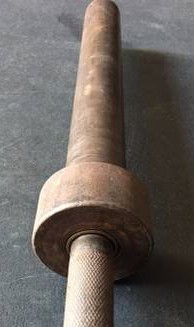
This one will be a lot of work to restore
When the outside is very rusty, the inside is probably worse.
A bit of rust on the shaft only isn’t a cause for concern. However, is it the “bad” kind of rust? If it’s smooth to the touch and doesn’t come off on your hands, it’s a patina, which is an inactive, thin oxidation that formed slowly, doesn’t develop further, and actually acts as a protective coating over the bar against active rust. Patina won’t rub off on your hands. A lot of people actually like bars that have developed a patina. It happens with bare steel bars or bars with coatings like black oxide that tend to rub off quickly with a lot of use, when the bar is kept in a commercial gym or a basement and not out in the garage.
Rust on the sleeves, or a rusty bolt on the end that holds the sleeves on, means the inside of the sleeve is rusty. It probably has spent time outside or in a tropical (humid) climate.
You want to avoid rust if possible, but rust actually isn’t a deal breaker if you have the right tools to clean it. Bars can be disassembled and cleaned up quite nicely. See our olympic bar maintenance and removing rust guide for details.
Make Sure It Spins
Barbell sleeves that don’t spin well, or don’t spin the same on either side, could have built-up rust in them.
The second cause of this would be it has gone dry from oil leaking out, and it just needs oiling. See the olympic bar maintenance article referenced above. Basically you just need to get a hold of a light oil and try dripping it down the edge of the shaft into the sleeve. Sometimes it’s a good fix and that’s all it needed. More modern bars this doesn’t happen to. They get made with sealed sleeves and a grease lubricant instead of oil that doesn’t leak out.
Sometimes it can be a manufacturing defect, but generally those are returned to the manufacturer at the time of purchase and you don’t see them around on the used market. I ran into a couple new bars in the past with a locked up sleeve. The manufacturers replaced them, of course.
Chrome Chipping
Chrome is one of the most common bar finishes. When it starts to chip anywhere on the shaft or sleeve, there’s probably a layer of rust under the chrome that is causing it to separate. At that point there’s certainly rust in the sleeve too. You’re not only going to have to disassemble the sleeves but also take a wire brush and get all the chrome off the bar, leaving a bare steel bar, or it’s just going to keep chipping on you and jab into your hands or fall in your eyes.
A badly rusted chrome bar was probably left outside and was probably made with cheap chrome. Good chrome is really effective at blocking moisture. It takes more than sweat and regular use to rust a bar that badly.
The Very Ends – Allen Bolt or Snap Ring?
Most all cheaper bars have an allen bolt (with a hex shaped hole) showing on the end. The allen bolt can be bent, broken, or come loose. Good bars don’t have these. They’re instead secured with snap rings (retaining rings), or York has a pinned sleeve, consisting of separate piece of sleeve at the end with a pin jammed through it that secures it well. In fact, I’ve never heard of York’s system failing, while snap rings occasionally break.
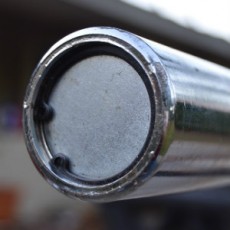 Snap ring 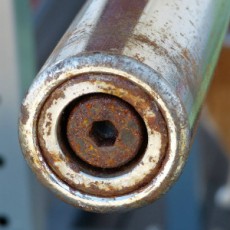 Allen bolt 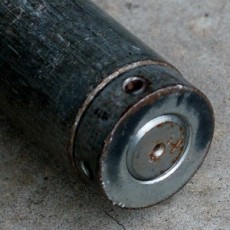 Pinned sleeve (pin showing at top) |
The kinds of bars with cheap allen bolts sell for like $115 new. Don’t pay more than $30 or so, even assuming it’s in great condition, or avoid it altogether and look for a good bar if you can.
Without an allen bolt it’s most likely a medium or high quality bar. Good sign!
The exception to this is at least one vintage Ivanko model they stopped many years ago, as below. You can see the “U.S.A.” engraving, which they only put on USA-made bars. This was a good bar with a strong and secure allen bolt. There could be some other such bars by companies no longer in business.
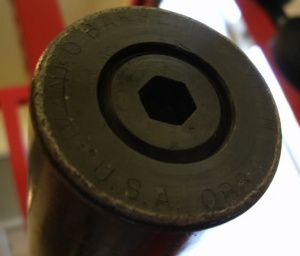
vintage Ivanko USA-made OB8
Is it Straight?
A slightly bent bar, noticeable only on close inspection, will get really annoying to lift with. When it’s not aligned just right at the start of your lift, it will want to rotate in your hands to push the bowed part upwards.
The bend might not be from abuse. And it might not be from being weak steel that got bent under ordinary lifting. Good cold-rolled steel isn’t always perfectly straight from the factory. Manufacturers have to sometimes use a press to force the steel straight before they add them to stock and start shipping them to customers. They either have to pay an employee to do that, or waste money by tossing ones that are slightly bent, or pay a premium to the fabrication plant to not send them any bent ones to begin with. So no matter what, it costs them, and that’s part of what you’re paying for.
To test a bar for straightness, the easiest way is simply to lay a bar down on the floor, spin the shaft with your foot, and see if the sleeves wobble.
Strength coach Mark Rippetoe demonstrates this method:
Play in the Sleeve
In other words, how much room the sleeve has to wiggle, either side-to-side or up and down as you shake it.
This is not a big deal if you’re not getting a bar for doing olympic lifts (snatches and cleans).
The direction of play is important to notice:
Side-to-side play is movement along the direction of the shaft. I suspect this can lead to snap rings breaking (which does happen), but I don’t know that for a fact. Nevertheless, I don’t like it.
Up-and-down play means the components aren’t made to the right diameters to fit snug. This will affect your olympic lifts in a significant way. When the fit isn’t snug against the bearings or bushings, the wobble interferes with and slows the smooth and sensitive rotation of the sleeve. Good spin, therefore, is not only about the bushing material but also how snug it is. Up and down play is what causes a ton of noise when dropped with bumpers.
There are plenty of high quality bars out there that have some play in them and make noise, so this doesn’t mean the bar is junk. Apparently getting everything assembled snugly is harder than it sounds. Still, this play is something to take into consideration if you’re doing olympic lifts. You can just spin the sleeves and see how sensitively and freely they spin despite room for wobble. It might be fine.
Knurling Length
Does the knurling go all the way to the end of the shaft? On cheap bars it never does. When it does, it’s a sign that the manufacturer put extra effort into it to accommodate lifters who need a wide snatch grip or wide squat grip.
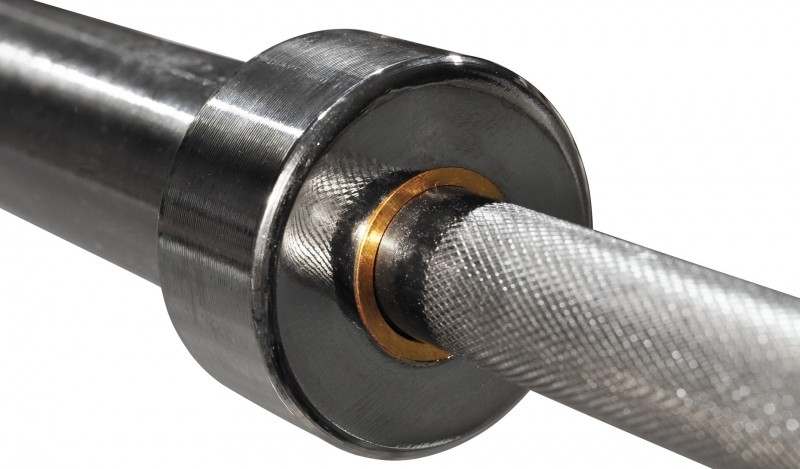
Nice bronze bushings showing, but the knurling stops 1/2″ short of the end. Not too bad, seeing as others stop 1″ short or more.
If it doesn’t, that doesn’t really mean much. Some high quality bars have knurling that stops an inch before the end.
Shaft Diameter
Well-trained hands can feel the difference between a 28mm and 29mm shaft, and even a 28.5mm shaft. 1mm extra diameter means 3mm added to the circumference, which is noticeable.
Otherwise you will need to rely on calipers. I use these calipers from Amazon; the top is inches and the bottom is cm/mm.
Cheap olympic bars tend to be made with 30mm shafts. That gives the bar significantly more load capacity over a 28-29mm bar (it doesn’t sound like much of a difference, but it does make a difference) despite being made of weaker steel.
That doesn’t mean all 30mm bars are garbage. There are high tensile strength 30mm bars made for pressing and squatting because that’s a more comfortable size for those lifts and it adds extra stiffness for those lifters putting up big numbers. It’s not fun for a powerlifter to be coming out of the hole in a max squat attempt and have the bar wobble around on him.
On the other hand, a 28-29mm bar tends to be at least of medium quality.
So just take a 30mm shaft as a possible sign of a cheap bar, taking into consideration the other aspects above.
Resources
Sometimes it’s possible to determine the model or at least the manufacturer. If you’re unsure, and you’ve got pics (from the outer end of the sleeve, and another showing the inner end where the shaft meets it), post them on the bodybuilding.com equipment forum. Those guys never seem to tire of “ID this bar for me” requests.
For a no-brainer approach, Rogue usually has some “boneyard” bars in their closeouts. These are actually brand new but have some cosmetic blemishes off the production line.

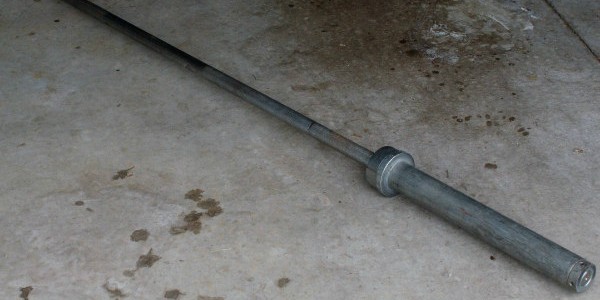
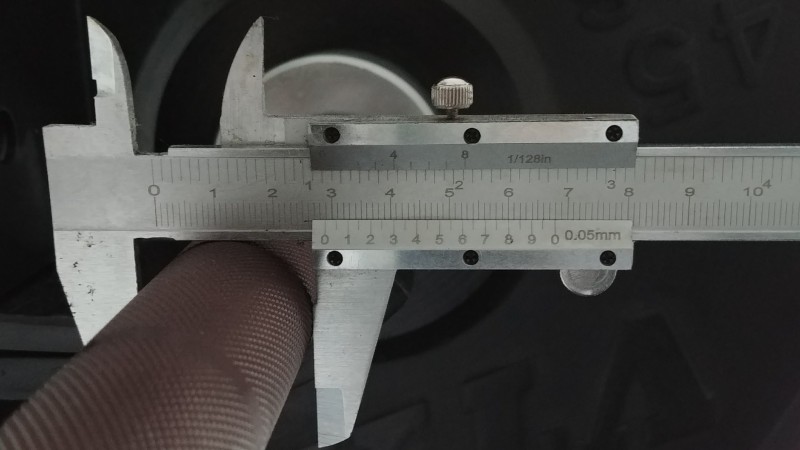
[…] Go for it! But don’t just buy the first “good deal” you come across. There are some things you’ll need to consider if you’re going to buy a used barbell. Check out this comprehensive guide to buying a used barbell from Two Rep Cave. […]
This is an excellent and very informative article!
I have myself just purchased a brand new 165 dollar Olympic barbell in order to start setting up my own home gym; however, the problem is that on one of its sleeve, there seems to be a minor wiggle going on due to its bushing not being equally circular around the shaft. The funny thing is that the other sleeve appears to be snug!
Would you suggest that this is normal? Or is it some type of a manufacturing defect?
Hi Dylan, It sounds like a warped bushing? Does it cause a louder noise when you drop it with bumpers? Or does it spin badly?
Yes, it does indeed seem to make that ‘clunky metal’ noise when I do shoulder shrugs and especially when I drop it with bumpers.
On both sides?
No, the noise seems to come from only the side where the bushing is not fitted equally along the shaft.
Photo #1: https://imgur.com/a/KBCsewR
Photo #2: https://imgur.com/a/v6SUZ63
No, the noise seems to be coming only from the sleeve which has the bushing not fitted equally along the shaft.
That’s probably the cause of it. What brand/model is it?
It’s a ‘Toorx’ brand olympic barbell.